Why Indian Agriculture/ “Annadata” Needs Support, in Measured Terms Bailout Package?
The Corona virus (COVID-19) endemic across the globe has caused substantial human and economic losses and disrupted food system value chain1. It has jolted the human minds and made to realise the vulnerability of human life to nature. Government of India is doing its best to control the spread of COVID to avoid major disaster in terms of human lives and economic losses in India. Government strategy started with “Jan hai to Jahaan hai” (health is wealth) and now moved to “(Jan bhi and jahaan bhi) (life and livelihood)”. Every day we hear people raising concerns about economy, industries, MSMEs, Start-ups, banking, service sectors which contribute large share of national GDP. It will be a challenging task to get all activities on track let it be labour, transport, manufacturing, tourism, agriculture etc.
Essential services like food supply, medical, health, sanitation, law and order sectors are exempted during the lockdown. Main driver for the Indian economy is agriculture which contributes only 16-17 % to the national GDP. During lockdown, importance of operational food systems supply chain is much realised by everyone and its criticality for Government’s efforts to combat the Corona. Short supply of food items triggers instinctive hoarding, panic buying resulting in price rise which can be a cause of concern for the law enforcing agencies. Uninterrupted food system supply chain is closely linked with nation’s internal security during our fight against the Corona endemic.
Vocal sections of the society demand quickly bailout packages, support systems etc. but forget our “Annadata” and in case of failure of supply chain
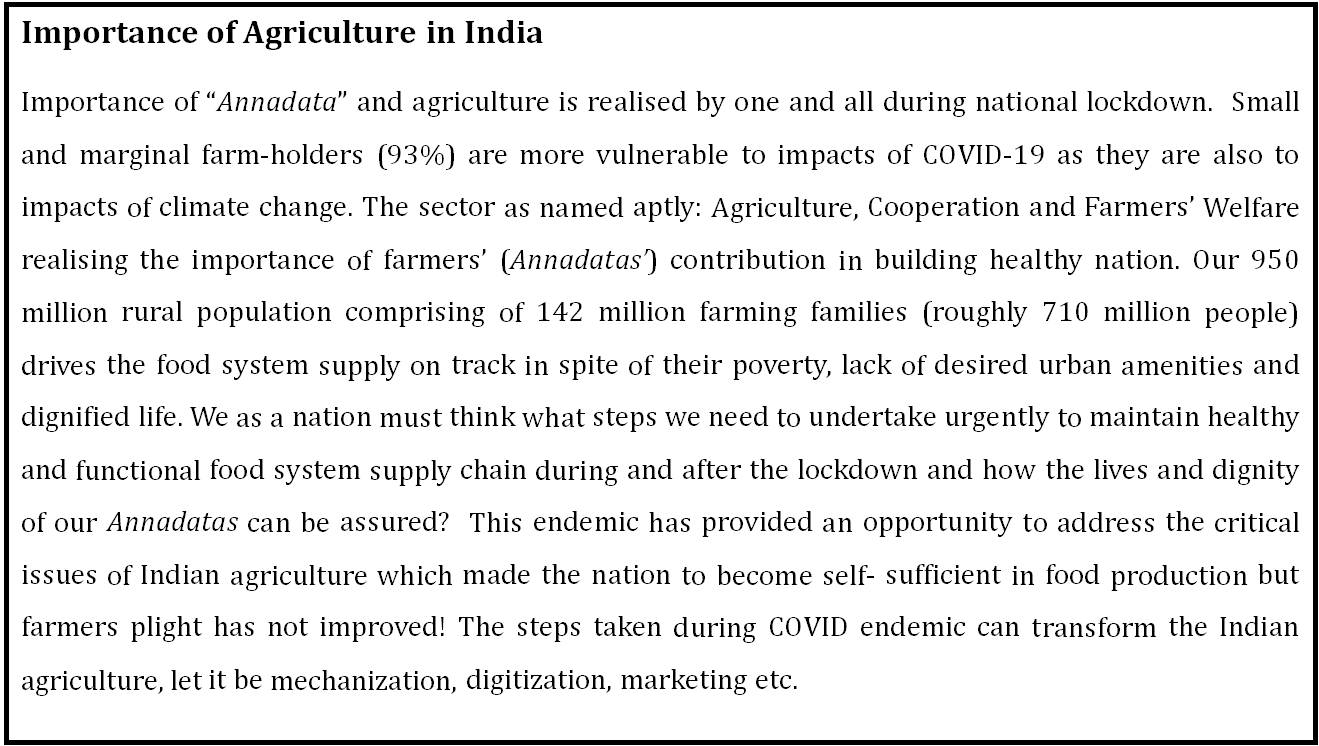
easy target is the government. We have seen governments falling with onion prices rising but never heard fall of the government due to increased gold, petrol, and electronic goods’ prices. Why we are looking at our Annadata in so much undignified manner?
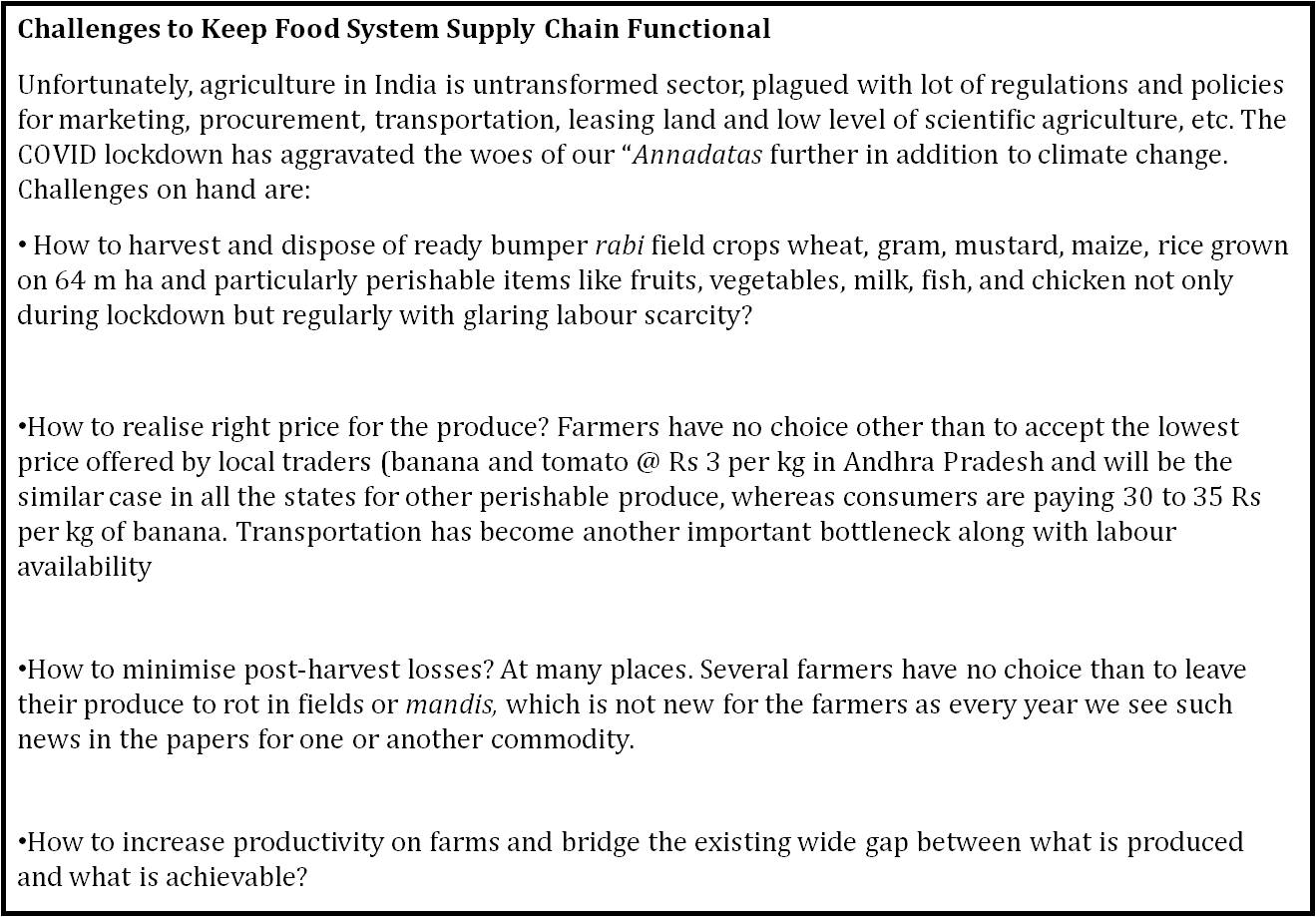
How Agriculture and Lives of “Annadata” could be Transformed to Ensure Functioning of Food System Supply Chain?
Government’s support to poor people through schemes such as Pradhan Mantri Garib Kalyan Yojana (PMGKY), increasing the MGNREGS labour wages, as well as releasing the instalment of Rs 2000 under the PM KISAN scheme directly in their accounts. However, the food factory owners in rural India need more to ensure the functioning food system supply chain in the country during and after the lockdown. One can argue that India has 585 million tonnes of rice and wheat2 (which our farmers have produced!) and country can manage with buffer stock. However, when Corona endemic has affected all the countries, India can turn this challenge in to an opportunity to transform agriculture and allied sectors to export after good harvest to and at the same time fix-up the systemic issues which are affecting the farming sector. Here we discuss what can help the farmers/“Annadatas” and agriculture which calls for resolving their issues urgently-
- not necessarily with dole outs;
- but through addressing the systemic issues through enabling policies and implementation for better
- Coordination, support system including transportation and movement across the states in the country to dispose farm produce at appropriate price,
- Better and efficient inputs supply chain for farming and allied sectors to enhance productivity,
- Ensuring timely operations in fields such as harvesting and threshing of rabi crops like wheat, chickpea (gram/chana), mustard, rice and other crops through ensuring labour supply and mechanization, and disposal at right price.
- As well as undertaking timely sowing of kharif crops and ensuring labour availability.
- Enabling policies to lease farm land and contract farming.
Fortunately, Indian Meteorological Department (IMD) has predicted normal and above normal coming monsoon season in addition to increased rabi area to 64 m ha with bumper harvest due to extended cold which is a silver lining during Corona endemic for the nation’s economy. Challenges/woes of agriculture/ “Annadata” can be gauged only by wearing farmers’ shoes and think like a farmer what he/she must be having on his/her mind at this juncture.
- The things whichare on their minds at the moment may not be only economic support from the government through PM KISAN.
- But timely logistical support to ensure harvesting of ready produce safely when labour scarcity is glaring at their face and disposed-off suitably at the right price (finding market, transportation and right price),
- Secondly how they can procure and transport the needed inputs (seeds, fertilisers, equipment, etc.) for upcoming kharif season during the lockdown at normal prices?
- How they can sow the rainy season crops when labourers have gone back to their native places? Usually also labour scarcity and increasing labour costs always trouble the farmers.
- Who will provide them credit at this juncture? and;
- How to produce food for the citizens of their country? Which they always do but never boast about!
What Can Be Done by the Government to Ensure Functioning Food System Supply Chain?
During challenging Corona endemic, the Indian leadership has demonstrated the power of coordinated approach through convergence of different ministries through cooperation of the public as also through collective action by creating high powered Task Forces to monitor and guide the process. This challenge can be converted into the opportunity to address the systemic efficiency issues in agriculture and gear-up the food system successfully. Bumper rabi harvest and prediction of normal monsoon can kick-start the Indian economy during and after COVID. Considering our “chalata hai” mind-set and careless attitude towards the farmers, it’s time to streamline the agriculture. Lot of advice on what to do- is there but our challenge is how to do on ground across the country? We put forward following action points which need urgent attention at appropriate level for implementation by adopting the principles of Coordination-Convergence-Cooperation and Collective action (4Cs) which the authorities have adopted to take on the CORONA challenge successfully and can successfully be harnessed for transforming agriculture.
During this period the major area of care and attention would be the identification of logistical bottlenecks especially movement of farm produce and inputs required. The perishables (fruits, vegetables, milk, meat, fish etc.) need urgent actions because of the danger of spoilage during transportation and the manner (including refrigeration) to be done. Demand for chicken and fish has come down because of unfounded fear that consumption of non-agricultural produce during this period may be harmful. Many farm workers may be reluctant to move over long distances because of fear that a sudden surge may lead to their being stuck far away from their homes and family as earlier. Government of Uttar Pradesh has set-up Committees chaired by District Magistrates to help the farmers. Procurement period for rabi crops is extended and government of Punjab has extended the time from 8h to 13 h for mechanical harvesters/combiners in the state. Bihar government has hired combine harvester drivers from neighbouring states to help farmers to harvest their crops.
It’s a golden opportunity to develop and strengthen sustainable and proven model of developing rural economy and to harness huge untapped agriculture’s potential to be a leader and strengthen “Make in India” policy by all the states along with central government. Decentralised manufacturing of identified products under “One Product-One District” in rural areas would cut down transportation, reduce overcrowding of the cities and provide employment in rural areas. Farmers cannot be part of the value chain except providing raw unprocessed material resulting in lower price (30-35%) realisation at farm gate of what consumers pay3 due to small land-holdings. During lockdown, good example has emerged in Himachal Pradesh where small farmers and labourers are selling their vegetables at local markets and colonies at cheaper rate (Peas @ 40 Rs/kg) than what organised chains are selling (e.g. peas @ 50 Rs/kg) and realising better price than in mandis. Similarly, Himachal youths who were averse to go to fields (this is true across the country) are happily plucking peas in fields as they see post-lockdown employment opportunity in agriculture. Building on the positivityIndian agriculture and lives of Annadatas in the country can be transformed and put back on sustainable track.
Action Points
- To identify and overcome the bottlenecks dedicated HELP DESKS need to be established at Tahsil/Taluka/Mandal and District levels to attend to all logistical and transport issues and to attend to farmers’ medical needs including falling prey to the virus. Even those farmers who ordinarily would have been quite independent may need assistance because of illness or economic stress. The very nature of their jobs and difficulty of maintaining social distance makes them more vulnerable and this institutional arrangement would provide essential moral and psychological support.
- Integrated micro-watersheds for decentralised water management must be strengthened to develop sustainable models for increasing productivity and profitability of the agriculture during climate change. Number of watersheds can be integrated at Farmer Producers Organizations (FPO) level as well as the power of new science tools like remote sensing, drones, GIS, simulation modelling, capacity building using IT tools, and developing value-chains. Through efficient water management area under rabi crops can be increased.
- Farmer Producer Organisations (FPOs) rightly pursued by government need to be empowered by creating an eco-systemensuring finance as well as professional experts to strengthen value-chain and marketing in the country to overcome the problems of small land holdings through collectivization and cooperation to make agriculture remunerative.” One District One Product” through empowered FPOs can ensure right price for the farmers and consumers as well as create rural employment. Although, thousands of FPOs are registered (10,000 more to be formed in five years as per 2019 budget), very few of them are really performing. We need to move from target-based formation of FPOs to performance based functional FPOs. Such FPOs will help the “Annadatas”, reduce pressure on cities, generate rural employment, and also reduce carbon and water footprint. Government can support appointing professionals initially on priority to develop and run the FPOs as business model identified in the clusters to do processing, packaging, and marketing/e-marketing. The FPOs take-up sell of current farm produce particularly the perishable items like fruits and vegetables directly to the consumers with or without AMC. During COVID-19 endemic prices of fruits and vegetables have fallen by 20% as hotels and restaurants, hostels are shut down. 4 At state and district levels the authorities need to facilitate the coordination across different agencies to enable movement of farm produce, arranging transport vehicles (including autos, e-rickshaws, small vans etc. to overcome the shortage of transport vehicles as done by the U.P government) and facilitating permits/passes to transport smoothly the vehicles carrying the farm produce as done by Department of Horticulture and Department of Agriculture Marketing, GoAP, who is running 502 mobile “RythuBazars” delivering fruits and vegetables at customers’ doorstep. The empowered FPOs can become direct suppliers of vegetables, fruits, fish, chicken, and other agricultural products including processed cereals and pulses to on-line marketing channels like Big Basket, Big Haat, Grofers, Flipcart, Amazon and others in addition to direct consumers in vicinity. The empowered FPOs can also help in procuring quality inputs at reasonable price directly from the producers and also become procurement centres for farm produce and money can be directly transferred in farmers’ bank accounts by government. However, to achieve this in short time strong coordination across the relevant departments at state and district levels is must as well as drastic modification in the AMC act to enable farmers to sell the produce at farm itself. Governments can push this on priority and make it functional to handle perishable products like mangoes, grapes, straw berries, goose berries, banana, green peas, tomatoes, chillies, flowers, fish, chicken, and also cereals like wheat, rice, maize as well as pulses and oil seeds during and after COVID situation. This challenge can be turned in to an opportunity to benefit Annadatas as well as strengthen rural livelihoods and kick start the agriculture, the main driver of Indian economy. Harvesting, grading, packaging can be done while maintaining the social distance under the supervision of the FPOs. However, the challenge of labours availability at aggregation and transportation level can be resolved through MGNREGA. All small and marginal farmers may be supported to undertake field operations under MGNREGA.
- Mechanization of agriculture promoted by government has to be undertaken on priority in rapid mode implementation to bring in efficiency, cost reduction as well as to overcome the problem of labour shortages to protect economy. Timely harvest of rabi crops and sowing of kharif crops without mechanization solutions are difficult to see in short time. Professionally and financially empowered FPOs need to be harnessed for targeted impact. However, help of private agriculture machinery manufacturers and corporates such as Mahindra & Mahindra, John Deere, Ferguson, TAFE, Swaraj industries and others need to be roped in suitably to establish efficient and functioning machine hiring centres at FPO level as a business modelensuring servicing and capacity building for the machines ensured by the corporate houses. As normal Monsoon is expected we have a short time on hand to put the desired things in place. This will go a long-way by kick starting farm mechanization through FPOs. Mechanization of agriculture also needs Coordination, Collective action, Consortium and Capacity building. One can imagine thousands of FPOs running farm mechanization as business model creating lakhs of job opportunities in rural India and bringing in efficiency and profitability for the farmers in India by harnessing expertise of corporates dealing with farm machineries.
- Ensuring timely availability of agricultural inputs (seeds, fertilisers, seedlings, etc.) at affordable price is essential. Empowered FPOs can play an important role in aggregating the demand from the farmers, liaising with the manufacturers/producers of agricultural inputs, and government authorities to ensure smooth movement of needed farm inputs throughCoordination, Convergence and Collective action for success. Mahindra Samriddhi planned to reach 5 million farmers and help for procuring all inputs as well as machineries by 20205, Tata’s Rallis providing agri-services to the farming community-“Rallis Kisan Kutumba” 6 , e-marketing enterprises like ITC’s e-chaupal, Big Haat and many others can be proactively roped in to help the farmers.
- Financial support through PM-KISAN as well as some state government schemes by direct benefit transfer does help farmers and as GoI has already transferred Rs 2000 instalment, states also should transfer before season. Each farmer should have Kisan Credit Card before the coming rainy season as well as availability of credit through NABARD and other banks should be ensured and implemented. Temporary warehouse receipts for the farmers who wish to put their produce in warehouses may be provided to enable the farmers to get credit/loans from institutions.
- The National Sample Survey has indicated that 51% of the farmers in India do not get any extension support7 and to reach 142 million farmers technologies such as mobile phones, IT, artificial intelligence and remote sensing, drones must be harnessed to transform the agriculture through knowledge dissemination. There is an urgent need to have an integrated authentic platform (instead of several private and government platforms/APPS) with all available data sets about soils, weather, markets, prices, predictions, management of diseases, pests and nutrient & water management for delivering the advisories for the farmers as well as for e-transactions to get services. Government of India has initiated Farmer Zone initiative for potato and this should be expended to cover around 100 crops and all the states and UTs on priority by quick acceleration through coordination and collective action in partnership with the knowledge generating institutions (international and national institutions such as ICAR institutions, State Agricultural Universities, research foundations - knowledge/data processing IT companies and knowledge dissemination agencies such as state agriculture departments, Krishi Vigyan Kendras (KVKs), Non-government organisations (NGOs) and farmers organisations.
- High-tech agriculture using IoT, sensors, IT, RS, & GIS can enable the FPOs to undertake protected cultivation of high-value crops can attract the youths to agriculture and provide employment opportunities in rural India. There is an urgent need to transform agriculture in India to protected and efficient agriculture using high-end technologies and power of IT which is India’s strength.
- Abhishek, V. Bhamoriya, P. Gupta, M. Kaushik, A. Kishore, R. Kumar,, A. Sharma, and S. Sharma (2020). India’s Food System in the Time COVID-19, Econ. Pol. Weekly 55(15)ISSN(online)-2349-8846
- https:/dfpd.gov.in Foodgrain stocking norms
- Inba, S, .Roy, D, and Joshi, P K 2017. Temporal and spatial dynamics of pulse production. In:Pulses for Nutrition in India: Changing Patterns From Farm to Fork (eds. Roy, D. Joshi P.K. and Chandra, R), pp 63-108, IFPRI, Washington D.C. USA
- www.economictimes.indiatimes.com/news/economy by BhosaleJayashree
- https://economicstimes.indiatimes.com.Mahindra Samriddhi eyes 5-mn farmers, 600 centres by 2020.
- https://www.rallis.co.inAgri services-Rallis India ltd.
- NSSO (2013) Situation assessment survey of Agriculture Households in India (70thRound: July 2012-June 2013) Ministry of Statistics and Program Implementation, New Delhi.
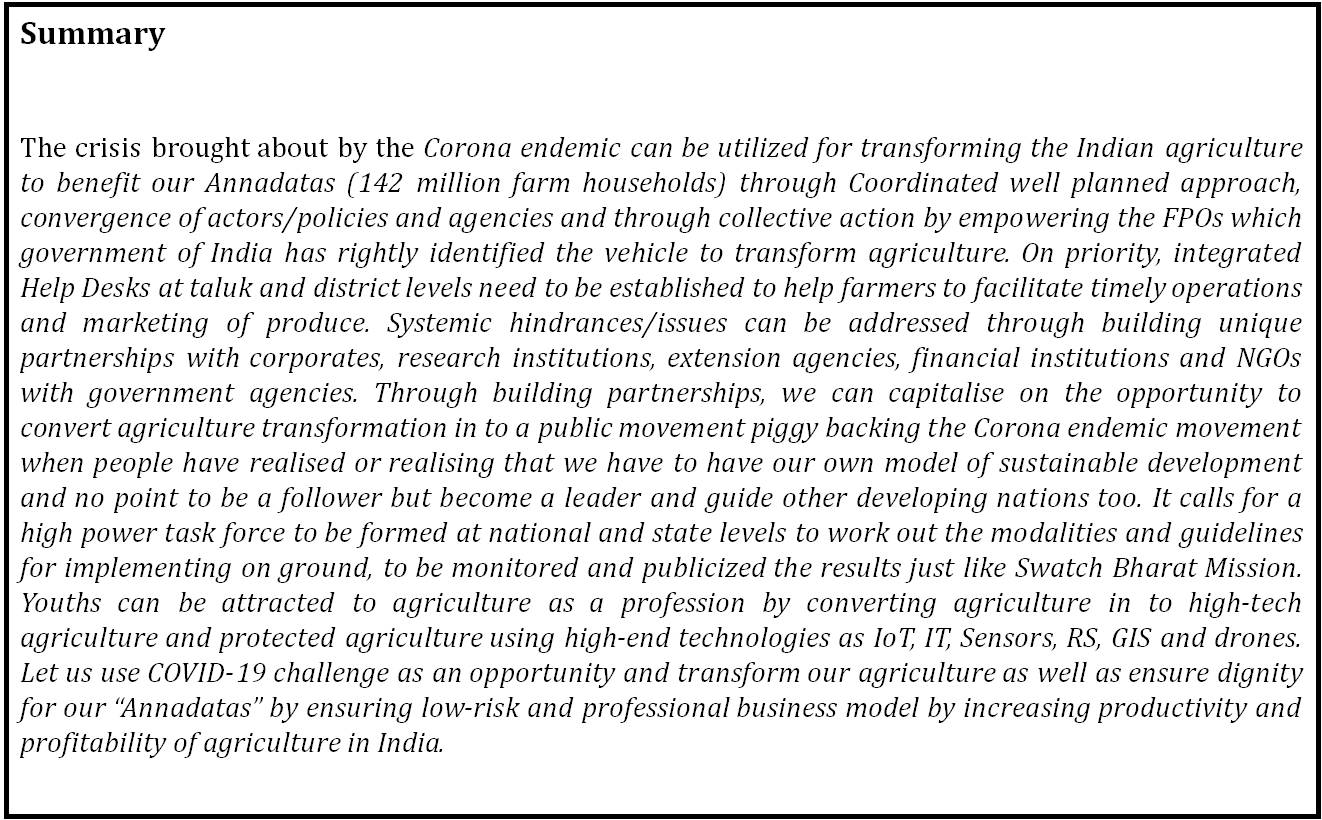
Acknowledgement: We kindly acknowledge the scholarly inputs through discussions with Drs. K V Raju, Economic Advisor, GoUP, P K Joshi, former Director Asia, IFPRI, New Delhi and Shobhan Pattanayak, former Secretary, DoAC & FW, India.
Endnotes
(The paper is the author’s individual scholastic articulation. The author certifies that the article/paper is original in content, unpublished and it has not been submitted for publication/web upload elsewhere, and that the facts and figures quoted are duly referenced, as needed, and are believed to be correct). (The paper does not necessarily represent the organisational stance... More >>
Image Source: https://images.newindianexpress.com/uploads/user/imagelibrary/2020/4/12/w900X450/tomato_field_EPS.jpg

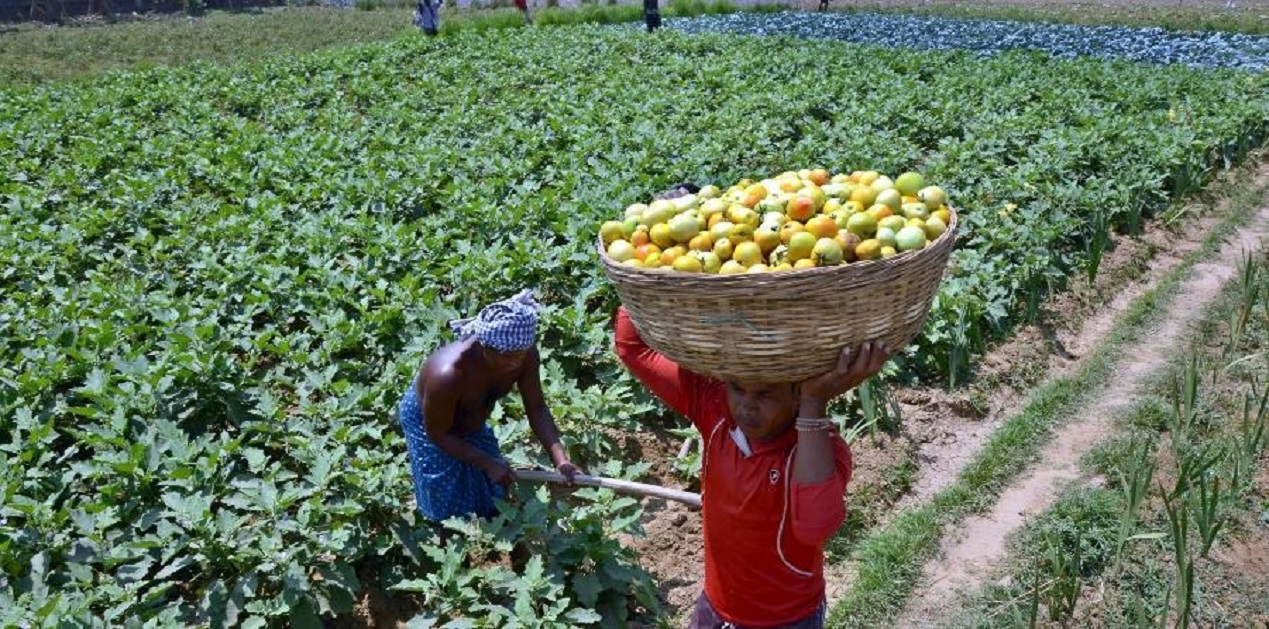
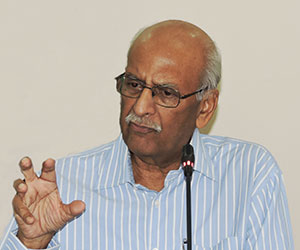









Post new comment